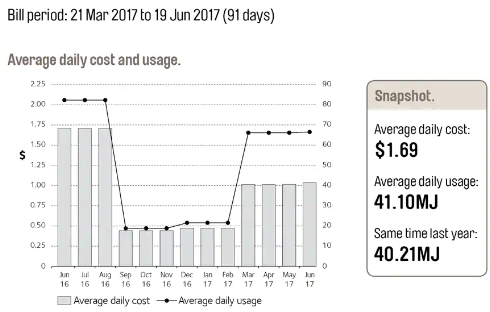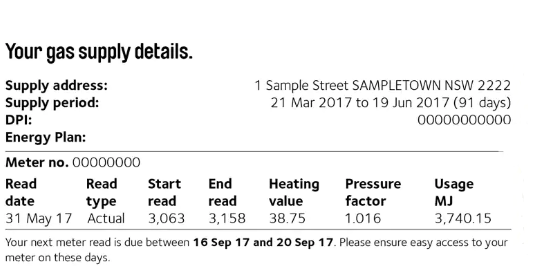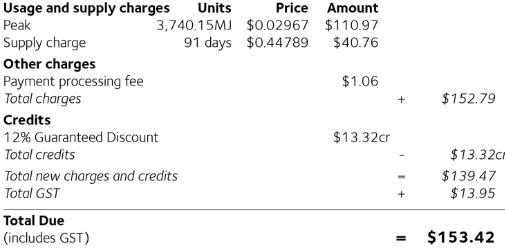In this article, Canstar Blue will explain what a megajoule is and how you can use this knowledge to get more information out of your gas billing, and maybe even save some money.
If you have natural gas at your property, you have probably noticed there are a lot of numbers on your bill followed by ‘MJ’. But what does that even mean? And, how does it work when comparing plans and understanding your gas bill? In this guide, we reveal all you need to know about megajoules, including how the different states and territories charge these rates on your natural gas plan.
On this page:
What is a ‘MJ’ in gas?
MJ is an abbreviation for megajoule, which is a unit of energy equivalent to one million joules. A property’s gas usage is measured in megajoules and recorded using a gas meter. This information is then passed on to your natural gas retailer for billing purposes. Your gas usage information (in MJs) will be detailed on your bill, helping you understand your gas usage habits and how you can save.
Gas appliances usually detail their energy efficiency in terms of megajoule-hours (MJ/h), that is, the number of MJs the appliance consumes in one hour. For example, a gas heater with an input of 25MJ/h will consume 25MJs in one hour.
If you see a gas appliance described in terms of just megajoules, you can safely assume it means its consumption is in MJ/h. If you notice that a gas heater or oven lists a kilowatt (kW) value instead, then that is referring to its heat output, not gas consumption. According to Elgas, at 100% efficiency, 1 kW of heat output will consume 3.6MJ of gas.
Compare natural gas plans in your state
Gas Plans Compared in VIC
Here are some of the cheapest gas deals on our database for VIC. These estimated annual costs are based on the Australian Gas Network in Melbourne and yearly gas usage of 29,830MJ, but prices will vary depending on your circumstances. We show one product per retailer, listed in order of lowest estimated cost. This table includes products from referral partners†. Our database may not cover all deals in your area, and please check retailer websites for up to date information.
Gas Plans Compared in NSW
Here are some of the cheapest gas deals on our database for NSW. These estimated annual costs are based on the Jemena Gas Network in Sydney and yearly gas usage of 18,542MJ, but prices will vary depending on your circumstances. We show one product per retailer, listed in order of lowest estimated cost. This table includes products from referral partners†. Our database may not cover all deals in your area, and please check retailer websites for up to date information.
Gas Plans Compared in WA
Here are some of the cheapest gas deals on our database for WA. These estimated annual costs are based on the ATCO Network in Perth and yearly gas usage of 7,672 (units), but prices may vary depending on your circumstances. We show one product per retailer, listed in order of lowest estimated cost. This table includes products from referral partners†. Our database may not cover all deals in your area, and please check retailer websites for up to date information.
Gas Plans Compared in SA
Here are some of the cheapest gas deals on our database for SA. These estimated annual costs are based on the Australian Gas Network in Adelaide and yearly gas usage of 11,875MJ, but prices will vary depending on your circumstances. We show one product per retailer, listed in order of lowest estimated cost. This table includes products from referral partners†. Our database may not cover all deals in your area, and please check retailer websites for up to date information.
Gas Plans Compared in QLD
Here are some of the cheapest gas deals on our database for QLD. These estimated annual costs are based on the Australian Gas Network in Brisbane and yearly gas usage of 6,842MJ, but prices will vary depending on your circumstances. We show one product per retailer, listed in order of lowest estimated cost. This table includes products from referral partners†. Our database may not cover all deals in your area, and please check retailer websites for up to date information.
What’s the difference between joule, kilojoule, megajoule and gigajoule?
With many different variations of the word joule, it’s easy to get confused. Here’s a comparison of the terms in order of unit of size:
- Joule (J): Smallest unit, used for scientific purposes or very small energy amounts (e.g. laser pointer heat)
- Kilojoule (kJ): Most common unit for food energy labelling (calories)
- Megajoule (MJ): Ideal for measuring gas consumption of homes, household appliances, industrial processes and large-scale energy generation
- Gigajoule (GJ): Used for extremely large energy quantities, like energy consumption of cities, natural gas pipeline capacities and large-scale power generation.
What do gas prices charged per MJ look like?
Natural gas customers are charged per megajoule of gas they use. Customers are usually charged on a block rate — which means they’re charged different rates depending on how much gas they use. Generally, the more gas that is consumed, the lower the usage rate will be for subsequent blocks of usage. For example, a typical gas usage block tariff might look like this:
| First 80MJ per day | 3 c/MJ |
| Next 50MJ per day | 2.8 c/MJ |
| Remaining usage | 2.5 c/MJ |
The figures in this table are a general guide only
The above example illustrates blocks of usage per day, however some gas providers may describe their blocks in terms of other measures of time, such as months or billing quarters. An example of that might look like this:
| First 5,000MJ per quarter | 3.1 c/MJ |
| Next 2,000MJ per quarter | 2.7 c/MJ |
| Next 1,000MJ per quarter | 2.4 c/MJ |
| Remaining usage | 2.3 c/MJ |
This figures in this table are a general guide only
Keep in mind that gas rates vary across different networks and states. For example, Western Australian and South Australian households tend to spend a little more on gas than customers in other states, while Victorian customers are often treated to some of the lowest gas prices in the country.
It is also important to note that WA gas bills and price fact sheets display gas usage in terms of ‘units’ rather than MJs, with one unit equivalent to 3.6MJ. This way, gas prices are comparable to electricity prices. Unlike in other states, gas prices in WA don’t vary that much between the different retailers as prices are regulated by the state government.
Average gas usage per day in MJs
According to our database, the estimated gas usage as reported by survey respondents in November 2023 is:
- 18,542MJ on the Jemena Gas Network in Sydney (around 50MJ per day)
- 29,830MJ on the Australian Gas Network in Melbourne (around 81MJ per day)
- 6,842MJ on the Australian Gas Network in Brisbane (around 18MJ per day)
- 11,875MJ on the Australian Gas Network in Adelaide (around 32MJ per day)
- 38,451MJ on the Evoenergy Network in Canberra (around 105MJ per day).
You might also be interested in:
How to read your gas bill
Your gas bill includes a lot of information, so it’s understandable if you struggle to make heads or tails of it. With that said, now that you have a better idea about megajoules and block rates, you can start to understand your bill a little easier. Keep in mind that the design of your gas bill and the information it includes will vary across retailers.
The front (page 1)

Most gas bills will include a graph similar to the one below that provides some insight into your natural gas usage over time. The left-hand side of this bill illustrates the average cost of gas in the most recent months, while the right axis illustrates average daily gas consumption. Knowing this information will help identify trends in your gas usage and whether you need to cut back to save.
The back (page 2)

Page two of the bill is usually a bit more technical. The ‘read type’ column indicates whether someone actually read your meter, or if the gas company instead made an estimate to bill you. The ‘start read’ column indicates the number on your gas meter at the end of your previous billing period. The ‘end read’ column indicates the number on your meter at your most recent meter read. The next column, heating value, is where it gets a little confusing.
Heating value is the amount of heat released through burning a quantity of supplied gas. The ‘pressure factor’ column takes into consideration the volume of gas-based pressure and temperature. Your total gas usage (in MJ) is calculated by subtracting the start read from the end read, and multiplying that result by the heating value and pressure factor. The end result is your real usage in MJ. This figure is then multiplied by your usage rate. Supply charges and extra fees are then added on as discounts are subtracted. The end result is the total amount you owe.

While you might just look at what you owe and then toss the bill out, it’s important to check this section to make sure you’re being charged correctly. If you’re not being charged correctly, don’t be afraid to take it up with your provider.
Read more: How to read your electricity bill
How to find a better gas deal
Understanding your gas usage is the first step towards finding a better deal. Now that you understand joules, megajoules and everything in between, you’re ready to get out there and compare providers. And what better way than through Canstar Blue’s free natural gas comparison tool? Here, you’ll find plans from about 17 providers and best of all, we won’t ask for any of your personal details. Simply type in your postcode and you’re good to go.
Image credits: tonton/Shutterstock.com



Share this article